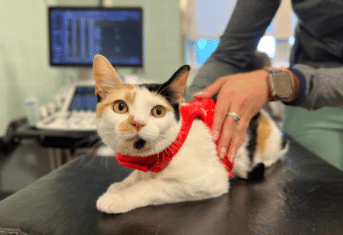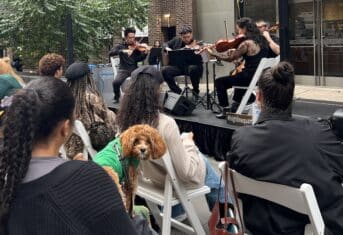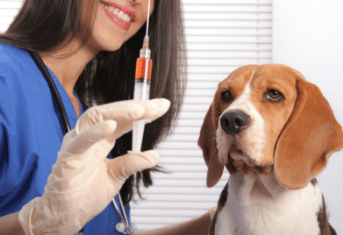Cranial Cruciate Ligament Disease in Dogs: What You Need to Know
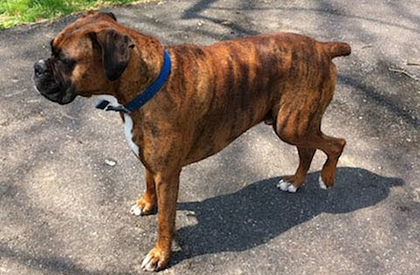
Cranial Cruciate Ligament Disease in Dogs: What You Need to Know
In response to a common search term on the Animal Medical Center website, this blog is devoted to cranial cruciate ligament disease (CCLD). The cranial cruciate ligament may not be familiar to many folks, but this ligament is analogous to the anterior cruciate ligament (ACL) of the human knee. Pretty much all of us know someone who has blown their ACL playing football, tennis or while skiing. Although the anatomy is similar in dogs and humans, the disease is quite different.
Ligament Anatomy
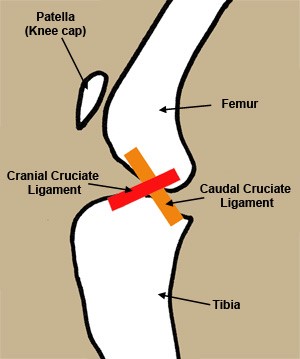
Like many things in anatomy, if there is a cranial (near the head) structure, you can be pretty sure there is also a caudal (closer to the tail) structure. This is true in the canine knee where there are both cranial and caudal cruciate ligaments as shown in the accompanying diagram. Together, these ligaments attach the femur (thigh bone) to the tibia (shin bone). The cranial ligament is the problematic one in dogs because it is critical to stabilizing the knee joint from both rotation and abnormal forward movement of the tibia. When the cranial cruciate ligament ruptures, the knee joint destabilizes, twists and slips, causing pain. If the ligament is partially torn, your dog may just limp, but after the ligament completely ruptures, dogs often walk on three legs. Joint instability can also damage to the cartilage in the joint known as the meniscus.
Weak Link Ligament
In people, rupture of the ACL typically occurs from some traumatic event. In dogs, the cranial cruciate ligament undergoes slow and chronic degeneration until finally the ligament weakens and ruptures. Because the disease process is degenerative, both the right and left cranial cruciate ligaments are often affected. Around half of dogs with one ruptured cranial cruciate ligament will rupture the second one. Overweight and out of shape dogs are also more likely to rupture a cranial cruciate ligament than those dogs in good condition.
Dogs at Risk
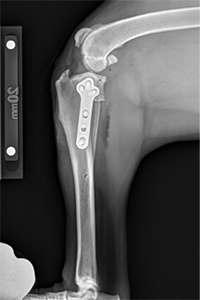
The perennial favorite, the Labrador retriever, and the massive Newfoundland are two breeds where a genetic inheritance of cranial cruciate ligament disease has been proven. Other breeds with an increased risk of CCLD include the Rottweiler, Staffordshire terrier, Mastiff, Akita, Saint Bernard and Chesapeake Bay retriever. Some breeds have been shown to have a decreased risk of CCLD and they are the Greyhound, Dachshund, Basset hound and Old English sheepdog. A ruptured cruciate ligament is extremely rare in cats.
Repair Options
At the Animal Medical Center, surgical repair of a ruptured ligament is preferred. Because every patient is different, the AMC uses several different surgical techniques to repair cranial cruciate ligaments. Two common techniques are known by acronyms: TPLO, which stands for tibial plateau leveling osteotomy, and TTA, or tibial tuberosity advancement. Both of these techniques cut and replace a section of the tibia using special bone plates. The bone is replaced in a fashion to improve joint biomechanics. The postoperative x-ray shown here demonstrates the TPLO repair.
Another type of surgical repair involves using suture material as a stand in for the torn ligament. The extracapsular lateral fabellotibial suture technique and the Tightrope® procedure are examples of a suture method of repair. Board certified surgeons at AMC prefer the TPLO and the extracapsular lateral fabellotibial suture techniques. Postoperatively, rehabilitation therapy is often prescribed to improve the rate of recovery through AMC’s Tina Santi Flaherty Rehabilitation & Fitness Service.
Dogs with an unrepaired ligament will develop severe arthritis in the affected knee, but surgical repair offers the chance of a good recovery with 80-90% of dogs returning to full function.































